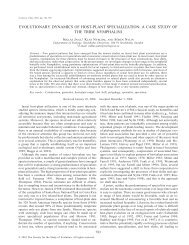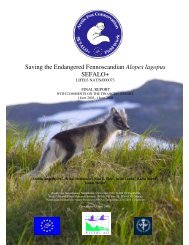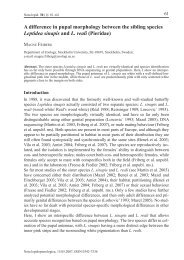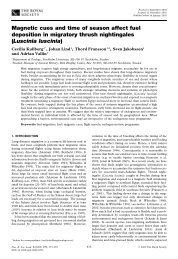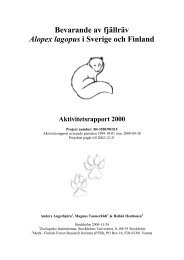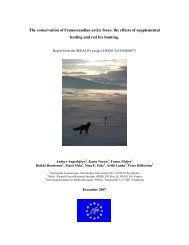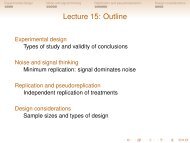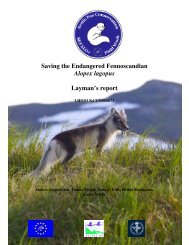Evolution of Fighting Behaviour: The Effect of Variation in Resource ...
Evolution of Fighting Behaviour: The Effect of Variation in Resource ...
Evolution of Fighting Behaviour: The Effect of Variation in Resource ...
Create successful ePaper yourself
Turn your PDF publications into a flip-book with our unique Google optimized e-Paper software.
GAMES WITH VARIATION IN RESOURCE VALUE 191A for a derivation <strong>of</strong> this result. If the mechanisms <strong>of</strong> <strong>in</strong>teraction are such that amore effective and costly strategy will impose a higher cost on the opponent, itfollows that S(V~) is more costly aga<strong>in</strong>st itself than S(V2) aga<strong>in</strong>st itself, and mostaggressive <strong>in</strong>teractions <strong>in</strong> nature clearly seem to be <strong>of</strong> this k<strong>in</strong>d, but there may beexceptions to this.Second, consider contests with a role asymmetry and with resource value be<strong>in</strong>gdeterm<strong>in</strong>ed by the role. Let V A and V B be the resource values (A and B denotethe roles) and S A and S ~ the local strategies that yield an ESS for the game withthese resource values. As already mentioned, no general prediction as to changes<strong>in</strong> costs when the resource value to one role is <strong>in</strong>creased can be made. Concern<strong>in</strong>gprobabilities <strong>of</strong> w<strong>in</strong>n<strong>in</strong>g, one would <strong>in</strong>tuitively expect that if, say, V A is <strong>in</strong>creased,then role A should w<strong>in</strong> more fights. This, however, does not follow generally fromevolutionary game theory. Proceed<strong>in</strong>g as <strong>in</strong> Appendix A, assum<strong>in</strong>g cont<strong>in</strong>uovsstability, one can show that role A becomes more "dar<strong>in</strong>g" as V A <strong>in</strong>creases, but <strong>in</strong>pr<strong>in</strong>ciple it is possible that role B also becomes more "dar<strong>in</strong>g", lead<strong>in</strong>g to a decrease<strong>in</strong> the number <strong>of</strong> fights won by role A. S<strong>in</strong>ce we have not found any biologicallyrealistic situation where this happens, we will not go <strong>in</strong>to details. In conclusion,when resource value to one role is <strong>in</strong>creased, the typical consequence is that thatrole will w<strong>in</strong> more fights, but there might be exceptions where the opposite is true.Third, consider a case where there is variation <strong>in</strong> subjective resource value amongcontestants but no correlation between the resource values <strong>of</strong> a pair <strong>of</strong> contestants.Assume <strong>in</strong> addition that the only means by which an <strong>in</strong>dividual can get <strong>in</strong>formationabout an opponent's use <strong>of</strong> local strategy based on subjective resource value is toobserve the opponent's behaviour dur<strong>in</strong>g a contest. It is then possible to give generalpredictions regard<strong>in</strong>g changes <strong>in</strong> probabilities <strong>of</strong> w<strong>in</strong>n<strong>in</strong>g and costs when an ESSprescribes variation <strong>in</strong> local strategies as subjective resource value varies. Namely,if an <strong>in</strong>crease <strong>in</strong> subjective resource value results <strong>in</strong> the use <strong>of</strong> a different localstrategy, then both the probability <strong>of</strong> w<strong>in</strong>n<strong>in</strong>g and the cost <strong>of</strong> an <strong>in</strong>teraction will<strong>in</strong>crease. A pro<strong>of</strong> <strong>of</strong> this statement is given <strong>in</strong> Appendix B (see Enquist et al. (1985)for a graphical demonstration).In the follow<strong>in</strong>g, we will give two examples <strong>of</strong> sequential assessment games withvariation <strong>in</strong> resource value. For both these examples, the <strong>in</strong>formational situationwill be <strong>of</strong> the third type above.<strong>The</strong> Sequential Assessment Game With <strong>Variation</strong> <strong>in</strong> <strong>Resource</strong> ValueA sequential assessment game models a contest that proceeds <strong>in</strong> steps, each stepentail<strong>in</strong>g a certa<strong>in</strong> cost or risk for a contestant. Contestants vary <strong>in</strong> their ability to<strong>in</strong>flict and avoid costs dur<strong>in</strong>g a fight, i.e. <strong>in</strong> their fight<strong>in</strong>g ability. Prior to an<strong>in</strong>teraction, a pair <strong>of</strong> compet<strong>in</strong>g <strong>in</strong>dividuals have poor <strong>in</strong>formation about theirrelative fight<strong>in</strong>g ability, but dur<strong>in</strong>g the <strong>in</strong>teraction they ga<strong>in</strong> more <strong>in</strong>formation anduse this <strong>in</strong>formation to decide whether to give up or to cont<strong>in</strong>ue fight<strong>in</strong>g.Subjective resource value may vary among contestants. <strong>The</strong>re might be a positivecorrelation between the subjective resource values (prior to a contest) <strong>of</strong> twocontestants, and <strong>in</strong> that case an <strong>in</strong>dividual could ga<strong>in</strong> <strong>in</strong>formation about an



